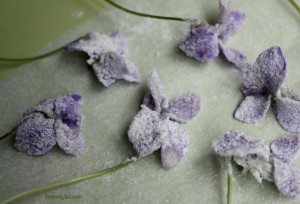The Common Blue Violet, Viola Papilionacea is native to Eastern North America. Hundreds of species of violet are found throughout the world. In Europe it has been valued for centuries and in Ancient Greece they were thought of as a symbol of love. Pliny the Elder, a Roman naturalist of the first century recommended a garland of violets around the head to prevent dizziness and headaches.

The Violet as Food
In Southern Ontario, Canada where I live, Common Blue Violets are in their prime in May. The plant’s rhizomes spread underground ensuring an abundant crop. So abundant that many gardeners regard the violet as an invader in their cultivated perennial beds and lawns. I consider the violet a beautiful and useful plant that is completely edible, – both leaf and flowers. The leaves may be used fresh in salads or eaten as a cooked vegetable. Violet flowers are high in Vitamin C. The flower’s vibrant colour makes it an intriguing culinary ingredient. It can be made into a jellies and syrups, used fresh in green and fruit salads and as I will demonstrate below, it can be candied for use in confections such as petit fours or cupcakes.
Gilding the Lily
I love to tell my friends that I’ve just spent the afternoon making candied violets and then wait for their reaction. I’m sure they think I have way too much time on my hands, but I know that when I serve them a small cake embellished with the delicate confection they will be fascinated and want to know how to make them. It is important to find a safe source to forage for the violets. If they are growing in a lawn be sure that the lawn has not be sprayed with pesticides, herbicides or chemically fertilized. Plan to make the candied violets on the same day they are picked because their life span is limited (even in water) after removal from their natural home.
Have the following items on hand: 1 egg, paper towel, parchment paper, clean water colour or makeup brush, 1/2 cup of confectioner’s sugar. This can be purchased or simply use regular refined white sugar and grind to a fine powder in a food processor. It is best to undertake this project on a dry day, but I made these during a rainy spell and they were fine. The operative word throughout the process is “gentle”!
Wash 2 doz. violets thoroughly and gently. Shake excess water and gently pat dry.
Before breaking, clean the shell of an egg with a cloth soaked in 3% hydrogen peroxide.
Whisk the white of an egg so that a slight foam appears on the surface. Use a clean watercolour or makeup brush to coat the frothed eggwhite onto the front and back of the blossom

Put the confectioner’s sugar in a small bowl. Put violet ‘face’ side down in sugar. Use a teaspoon to add sugar to the back of the flower.


Check that the violet is thoroughly coated with the sugar and place on parchment paper for 6 – 8 hours to dry. After the violets have dried, they may be placed in an airtight container and used within several weeks.
It is best to leave the stems attached for the time being. It will make it easier to handle the sugared blossoms – they become quite brittle.
Garnish a dark chocolate cupcake with the mauve flower. Pair with Autumnal Darjeeling tea. I like the harmony of a Spring flower being paired with an Autumn tea.

Iced

Another completely frivolous way to preserve the lush purple of the violet is to freeze it into ice cubes. Simply fill each cube compartment half full of water. Place one violet in each section, freeze and then fill to the top and freeze again. This method works best to prevent the violet from floating to the top. The Common Blue Violet has no flavour so may be added to ice tea for visual appeal only. Here I’ve added the cubes to The Meaning of Tea’s Organic Golden Monkey, a black tea from Yunnan province in China. I usually drink this tea hot but its strong flavour profile works well slightly sweetened with Agave nectar and iced.
Violets can be dried and added to any tea leaf without affecting the tea’s flavour. This could be an advantage if you want to preserve the character of the tea, but would like to create some colour drama in the infusion.
Have you had adventures with the Common Blue Violet, culinary or otherwise? Please do share!



